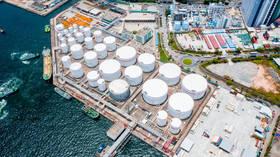The West thought oil sanctions would cripple Russia, here's why the plan backfired

In late December, Russian President Vladimir Putin responded to the price cap imposed by Western nations on Russian seaborne crude oil by signing a decree banning its supply from February 1 to nations that support the curb.
The US-led measure, which prohibited countries from paying more than $60 per barrel of Russian oil, came into effect in December. Putin’s response was an unequivocal declaration that Russia would not bow to sanctions pressure. His decree, however, includes the possibility of “special permission” to supply to countries that come under the purview of the ban – potentially a window of hope for some of those 27 EU members that are believed to have been coerced into supporting the price cap.
Redirecting supplies
The West’s cumulative bid to choke the Russian economy has not had the desired effect so far, as latest figures show. Russia’s budget revenues from the oil and gas industry grew 28% last year, amounting to $36.5 billion. Oil production in Russia rose 2% last year to 535 million tonnes, while exports of the fuel increased by 7.5%.
This was achieved in no small part, thanks to Moscow’s decision to redirect its supplies to India and China, while at the same time incentivising them to buy Russian energy with hefty discounts. While the country’s net energy export revenues declined by $172 million per day in December, supply quantities to Beijing and New Delhi have surged to an all-time high. Most of the decline came not from oil export revenues, but from pipeline natural gas exports that were eliminated by the sabotage of the Nord Stream gas pipelines.
China imported record quantities of Russian liquefied natural gas (LNG) in November – 852,000 tonnes, which is double the amount in the previous year, according to Chinese customs data. Sales of Russian crude oil and coal also surged.
Overall purchases of energy by China, including oil products, hit $8 billion in November, from a revised $7.8 billion a month earlier, meaning Russia overtook the Kingdom of Saudi Arabia to make it China’s largest supplier. Coal imports from Russia, including brown coal, rose 41% to 7.2 million tonnes of which 2.1 million tonnes (twice the amount a year ago) was coking coal for the Chinese steel industry.
Similarly, India, which is the world's third-biggest crude importer, bought a record amount of Russian oil in December, importing a whopping 33 times more than a year earlier. It purchased an average of 1.2 million barrels per day (bpd) from Russia in December 2022, compared to just 36,255 bpd in December 2021, according to data from Vortexa Ltd, an energy intelligence firm. Imports from Iraq and Saudi Arabia over the same period were about 1M bpd each. In the year before March 2021, 0.2 per cent of India’s oil purchases came from Russia. Currently, it’s over 25% of the total.
Interestingly, the US, the prime mover behind the G7 shenanigans, has all along been a big consumer of a refined Russian product called virgin gas oil (VGO).
Now, Washington is buying VGO from Indian refineries run by Reliance Energy and Nayara Energy – whose raw material is Russian crude oil.
A ‘weak’ idea
In hindsight, Ukrainian President Vladimir Zelensky appears to have been right when he called out the G7 oil price cap as a “weak” idea that was not “serious” enough to hurt Russia.
Despite the boycott call and amid fears of a global recession, demand for Russian crude oil – the world’s second-largest producer – didn’t taper off. Oil prices went up in the months following February 2022 because of supply concerns, but eventually ended the year at about the same levels as they had started. Russia not only didn’t slow production, but it stood to make more.
For instance, on the final trading day of last year, the spot price of Brent crude oil, a global benchmark, closed at $85 per barrel, just $7 higher than the price on January 3, 2022. Similarly, the spot price for West Texas Intermediate (WTI), a benchmark price for US crude oil, followed the same pattern, finishing the trading year at $4 per barrel higher than on January 3. The Brent crude oil spot price averaged $100 per barrel last year, and the WTI spot price averaged $95.
More sanctions, more pain – but for whom?
On February 5, the EU’s additional ban on Russian petroleum products, especially diesel fuel, came into effect. At the same time, the G7 instituted a global price cap – $100 on premium petroleum products such as diesel and $45 on products such as fuel oil. The stated goal behind these new sanctions is the same – to deprive Russia of one of its most important sources of revenue in a bid to choke off its ability to finance the conflict in Ukraine.
However, analysts have questioned the sanctions’ efficiency, predicting that Russia could simply redirect its supplies like it did with crude oil. The Western ban on refined products may even boost Russian crude supplies to China, which is a large refiner itself.
The measure could also prove to be more disruptive for Western European nations, which relied on Russia for about 40% of their refined product imports. Perhaps most importantly, Russian diesel made up for a deficit in their own production.
Diesel is primarily used for truck transport in ferrying massive consignments to consumers and to run agricultural machinery. The EU has deliberately shut down over 1 million bpd of refining capacity in the past few years due to the Covid-19 pandemic and global climate change concerns, and it remains to be seen how the bloc will replace nearly 500,000 bpd, which it used to import from Russia.















